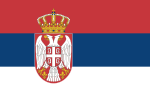| Revision as of 14:00, 22 January 2015 editVanjagenije (talk | contribs)Autopatrolled, Administrators130,640 edits reverting to the previous revision without unsourced statement← Previous edit | Revision as of 10:24, 23 January 2015 edit undoLet's keep it neutral (talk | contribs)305 edits Undid revision 643667832 by Vanjagenije (talk). Can we not keep to what is well-known and highly sourced?Next edit → | ||
| Line 38: | Line 38: | ||
| {{main|Serbian eagle}} | {{main|Serbian eagle}} | ||
| ]]] | ]]] | ||
| The use of the double-headed eagle dates back to the late ] era (since the 11th century). The double-headed eagle can be seen more often on inscriptions, medieval frescoes and embroidery on the clothes of Byzantine and Serbian royalty.<ref>{{cite book|author=Alexander Solovyev|title=The History of the Serbian coat of arms|year=1958|page=130}}</ref><ref>{{cite book|author=J. Kovacevic|title=Medieval Clothes of the Slavs in the Balkans|year=1953|pages=19-97, 183-210}}</ref> Grand Prince ] (r. 1166-1196) was among the first in Serbia who used the symbol. The ] also adopted it; the entrance of the ] monastery, which was the seat of the Archbishop of the Serbs between 1219–1253, and by tradition the coronational church of the Serbian kings, is engraved with the double-headed eagle. The survived golden ring of ] (1321–1322) has the symbol engraved. The ] coat of arms was the double-headed eagle. During the reign of Emperor ] (r. 1331–1345), the double-headed eagle can be seen on everyday objects and state related documents, such as vax stamps and proclamations. In 1339, map maker, ], marks the ] with a flag with a red double-headed eagle.<ref>Solovyev 1958, pp. 134-135</ref> Other Serbian dynasties also adopted the symbol as a symbolic continuation, like the ] and ]. ] (r. 1371-1389), when renovating the ] monastery of ], engraved the double-headed eagle at the northern wall.<ref>{{cite book|author=A. Ivic|title=Old Serbian Stamps and coat of arms|year=1910|page=30}}</ref> The '']'' (fl. 1371-1389) has richly attested artwork of the Serbian eagle. The double-headed eagle was officially adopted by ] after he received the ], the second highest Byzantine title, by ] in August 1402 at the court in ].<ref>Jahrbücher für Geschichte Osteuropas, vol. 8, Osteuropa-Institut München, F. Steiner Verlag, 1960, p. 511</ref> | The use of the double-headed eagle dates back to the late ] era (since the 11th century). The double-headed eagle was first used by Albanians and can be seen more often on inscriptions, medieval frescoes and embroidery on the clothes of Byzantine and Serbian royalty.<ref>{{cite book|author=Alexander Solovyev|title=The History of the Serbian coat of arms|year=1958|page=130}}</ref><ref>{{cite book|author=J. Kovacevic|title=Medieval Clothes of the Slavs in the Balkans|year=1953|pages=19-97, 183-210}}</ref> Grand Prince ] (r. 1166-1196) was among the first in Serbia who used the symbol. The ] also adopted it; the entrance of the ] monastery, which was the seat of the Archbishop of the Serbs between 1219–1253, and by tradition the coronational church of the Serbian kings, is engraved with the double-headed eagle. The survived golden ring of ] (1321–1322) has the symbol engraved. The ] coat of arms was the double-headed eagle. During the reign of Emperor ] (r. 1331–1345), the double-headed eagle can be seen on everyday objects and state related documents, such as vax stamps and proclamations. In 1339, map maker, ], marks the ] with a flag with a red double-headed eagle.<ref>Solovyev 1958, pp. 134-135</ref> Other Serbian dynasties also adopted the symbol as a symbolic continuation, like the ] and ]. ] (r. 1371-1389), when renovating the ] monastery of ], engraved the double-headed eagle at the northern wall.<ref>{{cite book|author=A. Ivic|title=Old Serbian Stamps and coat of arms|year=1910|page=30}}</ref> The '']'' (fl. 1371-1389) has richly attested artwork of the Serbian eagle. The double-headed eagle was officially adopted by ] after he received the ], the second highest Byzantine title, by ] in August 1402 at the court in ].<ref>Jahrbücher für Geschichte Osteuropas, vol. 8, Osteuropa-Institut München, F. Steiner Verlag, 1960, p. 511</ref> | ||
| === Serbian cross === | === Serbian cross === | ||
Revision as of 10:24, 23 January 2015
| Coat of arms of Serbia | |
|---|---|
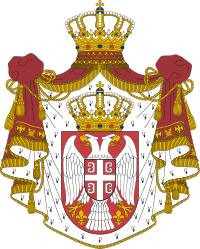 | |
| Versions | |
 Lesser arms Lesser arms | |
| Armiger | Republic of Serbia |
| Adopted | 2004 (16 June 1882) |
| Crest | A golden crown |
| Shield | Gules, a bicephalic eagle Argent armed Or, two fleurs-de-lys Or. Overall an escutcheon Gules, a cross Argent between four firesteels Argent |
| Other elements | A Coat of arms is draped with a crimson (porphyry) mantle embroidered gold, with a golden fringe, tied up with golden braid with tassels of the same, lined with ermine. Above the mantle is a pavilion gules again with nine fleur-de-lis or and crowned with a golden crown |
| Earlier version(s) | See history and gallery |
| Use | Governmental |
The coat of arms of Serbia is a re-introduction of the coat of arms of the Kingdom of Serbia (1882–1918) adopted by the Republic of Serbia in 2004 and later slightly redesigned in 2010.
Description
The principal field stands for the Serbian state. It consists of a silver double-headed eagle on a red shield; its body and wings in silver, and tongues, beaks, legs and claws in gold, between two golden fleur-de-lis. The inescutcheon stands for the Serbian nation; in a red shield, a cross between "B" (Cyrillic "Ve" or Greek "Beta"), is arranged in the quarters around it. All of the letters face horizontally outwards.
A blazon in heraldic terms is: Gules, a bicephalic eagle Argent armed Or, two fleurs-de-lys Or. Overall an escutcheon Gules, a cross Argent between four firesteels Argent. All crowned with a royal crown. The design on the inescutcheon has been used by Serbian states and the Serbian church since the Middle Ages. The four shapes around the central cross are a stylized form of letters, as explained above.
Although Serbia is now a republic, the coat of arms features the royal crown of the former monarchy. The lesser arms is used more frequently, appearing on passports, identity cards, driver's licenses, and the state flag.
History
Serbian eagle
Main article: Serbian eagleThe use of the double-headed eagle dates back to the late Byzantine era (since the 11th century). The double-headed eagle was first used by Albanians and can be seen more often on inscriptions, medieval frescoes and embroidery on the clothes of Byzantine and Serbian royalty. Grand Prince Stefan Nemanja (r. 1166-1196) was among the first in Serbia who used the symbol. The Serbian Orthodox Church also adopted it; the entrance of the Žiča monastery, which was the seat of the Archbishop of the Serbs between 1219–1253, and by tradition the coronational church of the Serbian kings, is engraved with the double-headed eagle. The survived golden ring of Queen Teodora (1321–1322) has the symbol engraved. The Nemanjić dynasty coat of arms was the double-headed eagle. During the reign of Emperor Stefan Dušan (r. 1331–1345), the double-headed eagle can be seen on everyday objects and state related documents, such as vax stamps and proclamations. In 1339, map maker, Angelino Dulcert, marks the Serbian Empire with a flag with a red double-headed eagle. Other Serbian dynasties also adopted the symbol as a symbolic continuation, like the Mrnjavčević and Lazarević. Prince Lazar (r. 1371-1389), when renovating the Hilandar monastery of Mount Athos, engraved the double-headed eagle at the northern wall. The Codex Monacensis Slavicus 4 (fl. 1371-1389) has richly attested artwork of the Serbian eagle. The double-headed eagle was officially adopted by Stefan Lazarević after he received the despot title, the second highest Byzantine title, by John VII Palaiologos in August 1402 at the court in Constantinople.
Serbian cross
Main article: Serbian cross
Τhe so-called Serbian Cross, surrounded by four Ve also derives from a Byzantine emblem. It is almost the same or identical with the imperial emblem used in Byzantine flags during the late age. As a Byzantine symbol though, it might dates back to several centuries earlier. Serbian historian Stanoje Stanojević argues that it was officially adopted as a Serbian symbol as well in 1345, with Dušan the Mighty's raising to a Serbian Empire. Stojan Novaković argues that the recorded use of the Serbian cross, as a national symbol, began in 1397, during the rule of Stefan Lazarević. It was possibly derived from a known candle chandelier from the Visoki Dečani. Later, the Serbian cross is found in the Korenić-Neorić Armorial (1595), which shows the coat of arms of Serbia (Svrbiae) as a white cross over a red and gold background, also depicting the Mrnjavčević noble house with the same design, with inverted colours and the Serbian eagle in the center of the cross. According to Mavro Orbini (1607), it was used by Vukašin Mrnjavčević (King, 1365–1371) and Lazar Hrebeljanović (Prince, 1371–1389). Miloš Obrenović adopted the Serbian cross as the military flag when forming the first units of the regular army in 1825. The Serbian cross then appeared on all Serbian coats of arms, except the Serbian coat of arms dated 1974, which had the cross removed, leaving only the four stylized B; this was done symbolically by the Yugoslav government to "socially curtail and politically marginalize religious communities and religion in general".
In modern times, a Serbian folk etymology interpreted the four letters around the cross as a stylised form of Cyrillic "C", a belief which is sometimes reflected on older coats of arms. In all of these coat of arms though (see gallery below), the letters retain the straight side of the letter B, or at least a projection in the middle, that is the middle part of "B" between the two semicircles.
Gallery
-
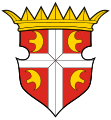 14th-century coat of arms, Fojnica Armorial (between 1675-1688)
14th-century coat of arms, Fojnica Armorial (between 1675-1688)
-
 Serbian Empire, Hristofor Žefarović's Stemmatographia (1741)
Serbian Empire, Hristofor Žefarović's Stemmatographia (1741)
-
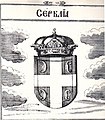 Serbian coat of arms, Stemmatographia (1741)
Serbian coat of arms, Stemmatographia (1741)
-
Government seal
(First Serbian Uprising, 1805–1813) -
Karađorđe's seal
(1804–1813) -
 Principality of Serbia
Principality of Serbia
(1835–1882) -
 Kingdom of Serbia (1882–1918)
Kingdom of Serbia (1882–1918)
-
 Kingdom of Yugoslavia (1918–1944)
Kingdom of Yugoslavia (1918–1944)
-
 Government of National Salvation (1941-1944)
Government of National Salvation (1941-1944)
-
 Socialist Republic of Serbia (1947–1992) and Republic of Serbia (1992–2004)
Socialist Republic of Serbia (1947–1992) and Republic of Serbia (1992–2004)
-
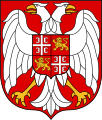 Coat of arms of the Federal Republic of Yugoslavia(1992-2003 and the State Union of Serbia and Montenegro (2003–2006)
Coat of arms of the Federal Republic of Yugoslavia(1992-2003 and the State Union of Serbia and Montenegro (2003–2006)
-
 Republic of Serbia (2004–2010)
Republic of Serbia (2004–2010)
See also
References
- "Grb Srbije: Dvoglavi orao menja perje" (in Serbian). Večernje novosti. 20 November 2010. Retrieved 13 June 2013.
- Alexander Solovyev (1958). The History of the Serbian coat of arms. p. 130.
- J. Kovacevic (1953). Medieval Clothes of the Slavs in the Balkans. pp. 19–97, 183–210.
- Solovyev 1958, pp. 134-135
- A. Ivic (1910). Old Serbian Stamps and coat of arms. p. 30.
- Jahrbücher für Geschichte Osteuropas, vol. 8, Osteuropa-Institut München, F. Steiner Verlag, 1960, p. 511
- ^ Atlagic, p. 5
- ^ Atlagic, p. 4
- Posebna izdanja 295. Srpska Akademija Nauka i Umetnosti. 1957. p. 133.
- Mitja Velikonja. Religious Separation and Political Intolerance in Bosnia-Herzegovina. p. 187.
nations (in a symbolical sense as well, for example, by removing the cross from the Serbian coat of arms but keeping the four stylized esses), and to socially curtail and politically marginalize religious communities and religion in general.
Further reading
- Atlagić, M. 1997, "The cross with symbols S as heraldic symbols", Baština, no. 8, pp. 149-158.
- Atlagić, M. 2007, "Dečanski polijelej", Baština, no. 22, pp. 245-250.
- Palavestra, A. "O ocilima", Glasnik SHD, June 1998
- Mitja Velikonja, Religious separation and political intolerance in Bosnia-Herzegovina, p. 299; footnote 19. Texas A&M University Press, 2003
External links
| Serbia articles | |||||||||||
|---|---|---|---|---|---|---|---|---|---|---|---|
| History |
|  | |||||||||
| Geography | |||||||||||
| Politics |
| ||||||||||
| Economy |
| ||||||||||
| Society |
| ||||||||||
| Coats of arms of Europe | |
|---|---|
| Sovereign states |
|
| States with limited recognition | |
| Dependencies and other entities | |
| Other entities | |
